Yasmin Y. Moosa, Diala M. Abi Haidar
Hekma School of Business, Dar Al Hekma College
Correspondence to: Yasmin Y. Moosa, Hekma School of Business, Dar Al Hekma College.
| Email: |  |
Copyright © 2012 Scientific & Academic Publishing. All Rights Reserved.
Abstract
Currently, career counselling services are offered in most of the higher education institutes in Saudi Arabia, however, there are no systems installed to automate these services. This paper takes Dar Al Hekma College (DAHC) in Saudi Arabia as motivation case and discusses the need of automating the college’s counselling and career services. By following the stages of SDLC, an effective system was developed for a real-world environment. The methods used for fact finding techniques were observations, interviews, questionnaires, and discussions. The survey outcomes have also shown a positive reaction regarding the impact of installation of such a system. Insights from this study can be applied to other higher education institutes in Saudi Arabia.
Keywords:
Career Counselling, Information System, Student Services, System Development Life Cycle (SDLC)
Cite this paper: Yasmin Y. Moosa, Diala M. Abi Haidar, Automating Counselling and Career Services in Saudi Arabia Higher Education Institutes, Management, Vol. 3 No. 7, 2013, pp. 459-474. doi: 10.5923/j.mm.20130307.17.
1. Introduction
Higher education institutions, both public and private, exist in a competitive environment but the decision to compete depends upon the institution. To be in competition, institutes of higher education should differentiate their services in order to attract different stakeholders. Students, staff, faculty, parents, alumni, sponsors, board of directors all serve as the stakeholder of higher education institutions. As students are the most immediate consumers of higher educational institute, thus the student services should be constantly developed, updated and groomed in response to the demands and expectations of their consumers[1]. Some examples of the student services provided by higher education institute include health services, library services, and technology services such as email access, E-learning, student information systems and others. One of the important services provided by most of the higher education institution is career and counselling services. These services are regarded as necessary for retaining students in the institute by counselling and guiding them throughout their college life and help them in choosing a proper academic program that suits their personality and define their future career path. Irrespective of all such services provided by the higher educational institutes, many students still find themselves lost when it comes to choosing a proper academic program. Some students do succeed in choosing an academic program but after retaining in that major for few years they feel the need to change their major because it did not match their expectation. This research paper takes Dar Al Hekma College in Saudi Arabia as a motivation case through which the authors will investigate why students still face problems in making career decisions in the availability of counselling and career services and what can higher education institutions do to reduce the problems faced by the students. Furthermore, by following the System Development Life Cycle (SDLC) phases, the authors will propose a solution for student problems’ such solution consists of automating the services and offering an online access for students across the country.The structure of this paper will be as follows: section 2 includes a brief literature review whereas section 3 includes a brief overview of the motivation case. Section 4 is dedicated to the overview of counselling and career services in Dar Al Hekma College. Section 5 describes the phases of SDLC as followed by the authors and their findings. Section 6 concludes the research findings while section 8 discusses some limitations of this research and proposed recommendations for future researchers.
2. Literature Review
A research conducted by A.G.Watts, discusses the role of information and communication technologies in integrated career information and guidance system[2]. Watts’s study is different from our research because he studied the application of Information and Communication Technology (ICT) in career information and guidance system in a general setting while our research was conducted in a higher education institute. Moreover, there were some connections found between the researches such as Watts’s study highlighted certain positive impacts of using ICT in career counselling that might be useful to predict the success of installing a system for career counselling in a higher education institute. Furthermore, Watts’s research shows that ICT can provide a client with “distance guidance” that is the opportunity of being free of space and time constraint which is one of the reasons Dar Al Hekma College students gave to automate the counselling and career services. Moreover, a study cited in Watts research proposes that ICT can develop a sense of self-awareness in the client by allowing the client to create his/her own profile and answer to some personality assessment questionnaires. In this way, the client completed personality profile will help him to be aware of the learning and work opportunities. “Creating a profile” is also one of the functions needed in the new system that is proposed by our research. Likewise, opportunity learning, decision learning, and transition learning are also some benefits achieved by automating the counselling and career services. In short, Watts’s research is important in terms of informing us about the benefits of the application of ICT in career and counselling services in general. But in our research, we will take a real world scenario and automate the career and counselling services for a chosen institute.Second, a research was conducted across Nigerian Secondary Schools[3] and cited that by integrating ICT with career counselling, the services would be efficient and effective in terms of flexibility and quality. The researchers of this study gave important insight about the reasons of why students utilize career counselling. Few of these reasons were relevant to our research and some of them will be discussed in section 5.1.1.1. Although, the research on Nigerian secondary schools and our research both were conducted on an education institutes yet there were some differences found:• The research on Nigerian secondary school studied the reasons of how students utilize career counselling in detail while our research focuses on the development of a system to enhance the utilization of the career services.• Nigerian secondary school research recommends using ICT in career counselling by making the students familiarize with the use of chat room, email and social networking sites. However, our research takes this idea a step ahead by proposing education institutes to develop or install a career counselling system that is specialized, customized and tailored according to the culture, context and needs of the students by which the students would create their own personalized profile that will aid the career counsellors to guide the student to an appropriate career. The reason behind such a customization is that the career counselling available online provides only general information and it does not take the context, location, culture and background of the student into consideration.By reviewing the literature, we came into conclusion that there is no such system proposed for career and counselling in Saudi Arabia. However, two researches were found that can be related to such a topic and were discussed above. The first one was only a study about the concept of applying ICT in career counselling in general. The second one was conducted in Nigerian secondary schools and described the reasons of why students utilize the career counselling. It further gave important insights about the increased flexibility and enhanced quality in the counselling and career services by using ICT. In the next section, the authors will introduce their motivation case, and will also describe different functions performed by the counselling and career services office at Dar Al Hekma College in detail.
3. Motivation Case
There are many higher education institutes for women in Jeddah however only two of them are not co-educational. One is Dar Al Hekma College and the other is Effat University. This makes them competitive because both the institutes have to compete to attract and retain female students across the city. Counseling and career services is offered in both the institutes but the services are not automated. So, in order to take precedence, the institutes need to differentiate their counselling and career services by increasing their ease of use, accessibility, usability and importance. One way to achieve this is to automate the counseling and career services which is currently manual. Thus, this project is also very important from a strategic and competitive point of view. In this paper the authors have studied the automation of the counseling and career services in Dar Al Hekma College only. However, the outcome of the study, i.e. system proposed, can be applied to other universities including Effat University as well. Established in 1999, Dar Al Hekma College is a non-profit institution of higher education for women situated in Jeddah city of Saudi Arabia. With it six undergraduate and two graduate programs, the college offers the finest teaching and educational resources and facilities for its students, faculty and staff. The academic degree programs meet national and international accreditation standards. The college building covers an area of 26,500 square meters and can accommodate up to 1500 students. It includes classrooms, computer labs, science labs, faculty and administrative offices, and a library all with a state-of-the-art learning environment. Services and activities includes prayer rooms, counseling and career services center, health services, recreational facilities, offices, meeting rooms for student clubs, lounges and common room, gym and cafeterias[4].
3.1. Counselling and Career Services Office at DAHC
Counselling and career services (CCS) office is a small department at Dar Al Hekma College, includes five employees (CCS staff) who perform three main functions listed below.
3.1.1. Counselling Students, Faculty and Staff
One of the functions of CCS is to counsel the clients (students, faculty and staff) regarding their personal, professional or academic matters. The client has to take appointment manually by visiting the CCS office where an administrative assistant would ask her to fill a form. The form is used to gather the client’s personal information like name, date of birth, reason for counselling session, number of visit, counselling session date and time, etc. In addition, the administrative assistant will also have to confirm the availability of the counsellor with respect to the timing given by the client. Once confirmed, the client has to visit the CCS to get counsel. After the counselling session, the counsellor has to update the form with the session details and give the client a new appointment date and time (if required). It is important for the counsellor to follow up with the client and see the client’s improvement after the counselling session. There are only two counsellors who perform this function.
3.1.2. Academic Assessment
Academic assessment is a new function added in this department. This function is carried out with the help of one clinical psychologist that would assess the clients, basically students, who need special help in academics. Students who face learning disabilities or problems like dyslexia, dysgraphia, arithmophobia (fear of numbers), and social anxiety disorder are usually assessed by this psychologist. She assess these students and based on their needs arrange workshops and/or special classes. The psychologist would create a plan to assess the students’ condition and implement different programs to improve results. Usually students are referred by a faculty member to be assessed by the psychologist. The process is that when a faculty would recognize a weakness in a student, she would recommend the student to visit the clinical psychologist and inform her about the student weakness. After the student visits the CCS office for her assessment, a report is prepared and sent to the referred faculty.
3.1.3. Professional Assessment
A professional psychologist (career counsellor) performs this function by advising the clients regarding their career path. The psychologist of profession assessment is visited by the current students, scholarship students, faculty and staff members, and job applicants. The profession assessment varies for each type of clients.a. Current students: There is no policy that forces all the students to seek career guidance. If the current students think that they need career guidance or they are not sure about the courses they are studying and how these can help them in their future career, they are welcomed by the CCS office. If the current students visit the CCS office for career guidance, they need to take appointment by filling a form. Once a form is filled and appointment is confirmed then the career counsellor will sit with the student. The counsellor will ask the student to take certain personality tests called “Introspection test” administered by CCS office staff (if required) to assess the student’s nature and character. The student is given another appointment to discuss the test result as the student will be guided based on her answers in the introspection test. Sometimes the career counsellor does not give an appointment to the student but they tell the student that they will be informed about the next appointment through an email or a text message. On the next appointment, the students are guided. The time require for this entire process varies and depends upon the work load of the counsellor.b. Scholarship students: All scholarship students are required by policy to visit the CCS office for profession assessment. They will take a test called “Professional interest test (PIT)” with the help of which the career counsellor would advise the student regarding the academic program they should choose to study. This PIT is administered by an external body and CCS office staff is not responsible for administering this test. A report regarding the appropriate major of the scholarship student is sent to the admission department. c. Faculty and Staff members: There is no policy that forces the faculty and staff members to seek career guidance from the CCS office. It is the responsibility of the faculty and staff members to visit the career counsellor in case there is a need. The CCS offices do serve them. CCS office has certain career test that would help the faculty and staff to create a career development plan with the help of a professional during the time they stay in the college. They only must visit the CCS office during the job interview and exit interview and are attended by the career counsellor. d. Job applicants: All job applicants are required by policy to visit the CCS office to be interview by the career counsellor. The career counsellor should send a report to the human resource department after assessing the job applicant.All the above described functions performed by the CCS department including taking appointments, taking tests, viewing results as well as transferring results are all done manually. In section 4, we will describe the process of automating these services by proposing a new system developed following the SDLC process.
4. The Development of a New System
The System Development Life Cycle (SDLC) is the overall process of developing software using a series of defined step[5]. It is also defined as “the activities that go into production of an information system solution to an organizational problem or opportunity”[6]. The phases of SDLC include planning, analysis, design, implementation and support and maintenance. For each phase, the authors have played different role such as system analysts, system designers, and programmers’ respectively. In this section, we will focus mainly on the analysis and design phases of the SDLC as they are the most important and comprehensive ones. The planning and implementation phase will be discussed.In the planning phase, the authors have collected the background information about the institute, different departments, organization chart, and have done in depth analysis of the processes performed by the counselling and career services office and understood how the department mission and vision is aligned with the College’s mission and vision. Different stakeholders were also identified.
4.1. Analysis Phase
There are three most important parts of the analysis phase which will be described in the coming sections. First, we can find the fact finding techniques that were selected to analyze the business process of the department and identify problems, opportunities and/or directives. Second are the problems of the department for which the authors are going to find system solutions. Third are the requirements of the new system collected from different users within the college. In the analysis phase, different functions or processes of the CCS office was illustrated by the use of different diagrams such as activity diagram, context diagram and Fishbone diagram which made it easier for the authors to understand, document and communicate their analysis with concerned users. We will first describe the fact finding techniques used in the analysis phase.
4.1.1. Fact Finding Techniques
Fact finding techniques are the tools used by the system analysts’ to gather information, understand problems and detect requirements. The users’ community is usually hesitant to request for a feature or is unaware about what the system analyst can actually provide, so they tend not to pronounce anything unless asked. Thus, this resistance of the users forces the system analyst to use fact finding techniques to help the user to better describe their problems and solution requirements. This process is often called requirements discovery[7]. The fact finding techniques used by the authors in this project varies and includes interviews, discussions, questionnaires, observation, sample of documents and forms. Thus, these tools helped the authors to understand the requirements of the clients and CCS staffs.1. Interview: Interview is a fact finding technique where by the authors collects information from individuals through face to face interaction. There are two types of interviews, unstructured or structured. Unstructured interviews are conducted with only a general goal or subject in mind and with few if any specific questions. The interviewer counts on the interviewee to provide a framework and direct the conversation. Structured interviews are in which the interviewer has a specific set of questions to ask of the interviewee[7]. The system analysts had conducted two interviews; one with the career counselor and the other with the system support officer in the Information Technology Department. The aim of the interview conducted with the career counselor was to know more about the process of the CCS office and the services that are needed to be automated. Moreover, other functional requirements were also investigated during the interview. The interview with the system support officer was to understand the technical environment of the institute. The interviews were beneficial because both the interviewee were very talented in their fields and provided detail overview of the questions asked. The interviews were both structured and unstructured.2. Discussion: Discussion is the action or process of talking about something, typically in order to reach a decision or to exchange ideas[8]. After each system development phase, the gathered information was discussed with the administrative assistant of CCS Office, who helped the system analyst to confirm the facts. The discussion was mainly based on the prepared flowchart, problem statements and use case diagrams and see whether or not it depicted the real CCS processes and appropriate user requirements or they needed modifications.3. Observation: Observation is a fact finding techniques wherein the systems analyst either participates in or watches a person perform activities to learn about the system[7].The observations used to take place on Sundays and Tuesdays from 10:00 am to 2:00 pm. These timings were picked because the college is usually full during these hours that will allow the system analyst to observe more events. These observation session have enlighten the system analysts’ with an overview of the problems face by the CCS and the important functions that are needed to be automated.4. Questionnaire: Questionnaire is a document that allows the analyst to collect information and opinions from respondents. This tool allowed the system analysts to collect facts from a large number of students. There are two types of questionnaires, free format questionnaire which is designed to offer the respondents greater latitude in the answer, whereas, fixed format questionnaire contains questions that require selecting an answer from predefined available responses[7]. The system analysts conducted the survey using an online tool “Survey Monkey”[9], which have helped to gather input from 156 responded around the college. This was the most useful to get useful insights about the client’s requirements and their needs for a system. Refer to Appendix A for a sample of questionnaire. The findings and analysis will be described in detail in section 4.1.2.5. Collecting Samples of Existing Documents and Forms: This tool involves studying existing documents, forms and files. Due to the confidentiality issue, the system analysts’ were only able to view the empty forms for taking test, forms to request for counseling session and other documents of report formation. Essentially, this technique has enormously helped the system analysts’ to know about the information requirement, test taken, counseling sessions, and other evaluation sheets.These mentioned fact finding techniques have helped the system analysts to gather a lot of information that will help to identify problems in the counseling and career services and provide automation as a solution in the delivery of these services by the use of information system. The user requirements were also determined in this phase. In the next section, the authors will discuss the problem overview.
4.1.2. Problem Definition
In this section, the authors will discuss the problem faced by the counseling and career services office staff and other stakeholders (student, faculty and staff) within the institution regarding the counseling and career services processes. First, we will discuss briefly our insights from the fact finding techniques and then we will summarize the main problems in points and discuss how they can be solved.The authors have found enormous problems in the counseling and career services office and most of the problems were because the information was stored and retrieved manually. There was no automated system to manage the enormous information provided the client (student, faculty, and staff) and hence resulted in lack of efficiency in the counseling services. − CCS Staff problemsThe appointment taking and confirming is done manual hence this results in wastage of time. The office was congested due to the presence of huge office cabinet, so if the administrative assistant wants to retrieve a specific test paper she has to search an entire file (within the cabinet) from beginning till the end. The reports prepared by the counselors are also sent manually as hard copies between the departments. Moreover, all the empty forms are printed and kept in the office to be used in time of need. Forms included tests, reports sheet, and forms for counseling sessions, etc. Some of the forms and test filled by the students are often being misplaced and the students need to retake the test or refill the form for counseling session. It was difficult for the counselor to follow up with students. The administrative assistant said that she keeps emailing and texting the student but gets no reply from them. − Student ProblemsThe student problems were gathered from the questionnaires. The authors discovered that most of the students were unaware about the counseling and career services that is offered by the institute. Almost 156 students were surveyed. Some questions were skipped by the students that’s why based on the attended questions we will analyze their problems. 72 students almost 46.7% of the students did not knew that the college offered counseling and career services. 33.7% of the students were aware. Even if the students were aware about these services, a huge number of students almost 110 out of 144 (76%) also agreed that they never visited the counseling and career services. While 78 out of 142 (54%) students think that the counseling and career services are very important for them. 48 out of 142 (33%) students hold neutral opinion regarding the counseling and career services. While, the rest 16 out of 142 (11%) think that the counseling and career services are not very important. 97 out of 146 (66%) students demand to automate the counseling and career services.11 out of 146 (7%) think that they will not be encouraged to use the services by the counseling and career office even if automated. 38 out of 146 (26%) think that they are not sure if they will use the counseling and career services after automating. Different reasons were given by the students for not utilizing the counseling and career services. 45% of the surveyed students said that they did not know this service that is why they did not use them. 11 % of students said that they feel shy to discuss these issues. About 7 % students said that they are lazy. 16% said that they do not want to share their personal information because they do not trust the confidentiality procedure in place. 20 % said that they do not have time and 26 % of the surveyed students affirmatively said that they do not have the counseling and career services in the institute. Some students also asked for online chat with the counselor and Skype sessions.− Other Departments ProblemsThere are two departments, Human resource department and the admission department as well as faculty members that need receive different reports from the counseling and career services office. They need the reports immediately in order to smoothly continue their process. These reports are sent manually as hard copies by the administrative assistant of the CCS office. Sometimes the students’ test paper gets lost in the process of transferring the test paper across departments. As a result, the students had to take the test again thus recreating inefficiency. To better understand the cause of the problem of students’ test paper getting lost, the system analysts’ has used the cause and effect diagram which is shown in figure 1.1. Note that the student test paper lost is not merely because of the CCS office inefficiency but a combination of other factors as well.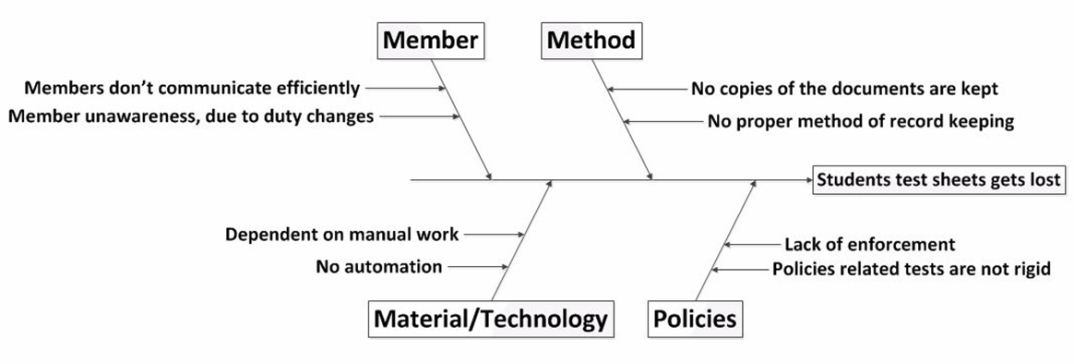 | Figure 1.1. Fishbone diagram showing the cause and effect of a problem |
Cause and effect diagrams document all the factors that contribute to or affect a given situation: all the causes, that is, that lead to a certain effect. They are also called Ishikawa, fishbone, or characteristic diagrams [7]. After studying the problems, we came to elucidate the requirement from the new automated system that is intended to provide solutions to the above problems.
4.1.3. Requirement Analysis
We are aware that automating the process and offering an online access is the only solution to the problems faced by the counseling and career services office staff, students and other departments. Hence, in this section we will discuss the requirement of the new system that will solve the problems. The system analysts’ have used a context diagram to comprehend the complex automated system. Figure 1.2 shows the context diagram of the counseling and career services office. The purpose of the system context diagram is to analyze how the system interacts with the world around it and to specify in general terms the input and outputs of the system. The line indicate the input (arrows pointing to the system) provided by actors to the system and the outputs (arrows pointing to the actors) created by the system. Understanding the system using a system context diagram is a solid first step[7]. − Solutions for CCS ProblemsNow, the new system will be automated and would help the CCS staff to store and retrieve the information more effectively and efficiently by the use of advance databases. The system will allow the client (student, faculty and staff) to take appointment online through the system without the need of the administrative assistant and the system will automatically check the availability of the counselor and confirm appointments. Follow ups will be easier as the CCS staff will be partial administrator of the system and can send an email to the student or inform a responsible faculty member to remind the student to visit the CCS office. Moreover, the CCS staff needs not to print out extra tests, form or documents as all these documents will be stored in the system database.− Solutions for Students ProblemsStudents will be given a user name and password for accessing the system when they are admitted to the college. This will create a sense of awareness among the students regarding the counseling and career services. Students who feel shy have an option to send anonymous message to the counselor, if they need counseling. Students who were not willing to share their personal information because of confidentiality issue they should be ensured that the system is 100% confidential and this should be mentioned in the system. Moreover, the password should be strong enough in order to ensure better security. According to a study mentioned in section 2, the online access will allow the client to be free of time and space constraint. Similarly, lazy students and those students who were previously constraint by time will have no restriction in using the counseling and career services.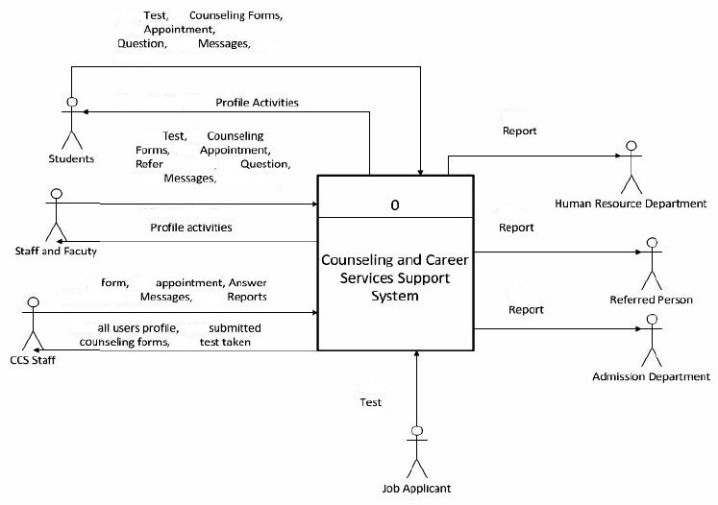 | Figure 1.2. the new system’s context diagram |
− Solutions to the other Departments ProblemsThe admission department requires the report of the scholarship students to continue the process of admitting them in a respective major. Similarly, the Human Recourse department requires the job applicant assessment report in order to process the applicants’ application and make decision on whether the applicants’ are acceptable for the job or not. By automating the system, the Human Resource department and the admission department interaction will no longer need to interact with the CCS department. They just need an access to the new system and retrieve a required report. The same solution is applied to the report to be viewed by the referred faculty. In short, the users required an automated counseling and career services system that would allow them to access the counseling and career services using a username and password. The system would include some information regarding the services provided by the Counseling and career services office to increase student awareness. A user manual should be distributed among the students either online or as a hard copy. The system should allow the students, faculty and staff to create their personalized profile. The students, faculty and staff can edit, view and update their profile information. System requirements are the requirement proposed by the CCS office members to be included in the new system. Functional requirements are defined as “what the system or application will do - specifically in the context of an external interaction” (with a client, or with another system). A Non-functional requirement is a requirement that specifies criteria that can be used to judge the operation of a system, rather than specific behaviors. Prioritized requirement is a strategy used to determine which candidate requirement is the most important compared to another requirement and implement the significant requirement first[7].This step of prioritizing the requirements was followed by the authors but was not shown in the Table 1. Table 1 describes the functional and non-functional requirements gathered from the users in detail.As described earlier that many diagrams were used in the analysis phase that helped to understand the process of the new automated system. Some of the diagrams were use-case diagrams, activity diagrams, sequence diagrams etc. In the next section only the use case diagram of the new counseling and career services system will be introduced.| Table 1. Functional and non-function requirement |
| | Requirement | Type | Explain | | Take Tests | Functional | The client’s demand to take the personality test and other tests online i.e. by using the system. | | Enter/Edit Profile information | Functional | After the client enters her profile information when she logs in the first time, then system should allow her to edit her information anytime. | | Generate reports | Functional | The CCS staff requested that she wants the system to generate reports and make them available to different departments using the system. | | Calculate Test score | Functional | One of the tests, MBTI, was requested by the CCS staff to be scored by the system. | | View or Print test taken | Functional | Once the client attempts a test and sends it to the CCS staff, the CCS staff can view or print this test. | | Update/Edit form | Functional | Once the client requests for counselling session, the CCS staff then can update the form after interviewing the client, thereof writing the recommendations. | | View all clients profile Information | Functional | The CCS staff can view all the accounts information, and their status. | | Query | Functional | The CCS staff can search for any clients using the ID or any other identifier. | | Fill a request for counselling session | Functional | The clients can fill a request for counselling sessions through. | | Give/take appointments | Functional | The system should be able to give appointments to the clients for any service they demand. | | Referring others | Functional | The system should have a referring option so that the faculty can refer any who is facing problems and need help by filling an online form. | | Skype sessions | Functional | Some clients have also requested to have a feature of online Skype session with the Counselor. | | Anonymous question asking | Functional | Some clients have requested to ask questions anonymously without their names being shown. | | FAQ’s | Functional | Some clients have requested to have a feature of frequently asked question to increase awareness about the Counseling services and tell the client more about what to expect. | | Perform Fast | Non Functional | The system should not take time to load and should perform fast. | | Accurate/ reliable | Non Functional | The system should be reliable in test scoring or appointment give that simply means no conflicts. | | Security | Non Functional | The system should be secure and have high levels of security standards. | | Backup and recoverability | Non Functional | There should be a way to back up lost data. | | User Friendly Interface | Non Functional | The user interface should be extremely friendly to avoid hesitance from clients. |
|
|
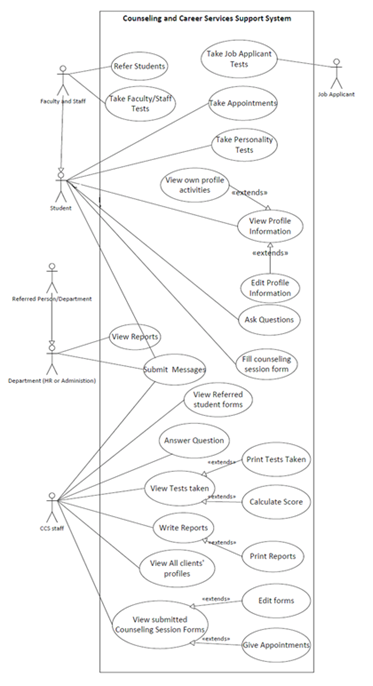 | Figure 1.3. Use Case Diagram |
4.1.3.1. Use-case Diagram
A use case diagram is a diagram that shows the interactions between the system and users. It is a graphical presentation of who will use the new system and in what ways the user is expected to interact with the system[7]. Figure 1.3 shows the use-case diagram of counseling and career services system. A use-case diagram technique helps the authors to better understand and document system requirements. This diagram was drawn in the analysis stage but with the development of other phases, it was refined. Different use-cases were initiated by external users called actors. In figure 1.3, the CCS staff, students, faculty and staff, HR department, admission department and referred faculty are all the actors of different use-cases such as take appointment, take personality test, and refer students, etc. It should be noted that there are different relationship called “associations” among the actor and use-case which shows the interaction occurs between them[7]. Relationships can also be between two use-cases. For example, as shown in figure 1.3, there is a relationship of “Extends” between the use-case “View profile information” and “View own profile activities”. The authors’ have also used activity and sequence diagram to have a detailed study of the process within each use-case relationship, sample of each diagram is shown in the Appendix B.This marks the end of the analysis phase. In the next section the authors will describe the design phase of the SDLC.
4.2. Design Phase
There are two main things that will be discussed in the design phase. First is the conceptual and logical design where the authors will play the role of system designers and will try to give a model to each data element. This step is important to eliminate the inconsistencies and redundancies in the future database. With the help of entity-relationship diagram (ERD), the authors’ with conceptually draw the entities, their attributes and relationships between the entities will be determined by business rules. The ERD is then mapped into logical relationship following the rules. Moreover, the primary key, foreign key are determined. After that, the logical design is converted into physical table where unique tables with fields, data type and storage space are determined[7]. Second is the SQL implementation of the physical table was done. The authors will show an overview of how the physical design tables were used to create a database in Microsoft SQL server.
4.2.1. Conceptual and Logical Design
This is an important step in SDLC because it provides the authors to understand the database design of the system. As described in the above section, first the conceptual model of the new system was designed. The conceptual model consists of identifying different entities and their attributes. For example, in our case CLIENT can be an entity because we need to store information about the clients i.e. the students, faculty and staff in the database.The attributes are the information to be collected about the entity. For example, client name, client email and client mobile can be attributes. The CLIENT can have a relationship of “select” with another entity TEST. Thus, the figure 1.4 shows the conceptual model of the business rule “A client can select a test”. Note that the relationship “select” means to “take a test”. The business rule would be “One client can take many tests; a test can be taken by many clients”Client ID and Test ID are the primary keys of the entities CLIENT AND TEST. Note that some attributes were removed for simplicity. The next step is to convert the ERD into logical relationships; the mapping of the ERD in figure 1.4 is shown in figure 1.5.When all the entities were mapped into logical deign, then the logical design were converted into physical tables, its storage space and data types are determined. In this next section, the authors will introduce the structured query language. The complete ERD and logical design can be found in appendix C and appendix D respectively.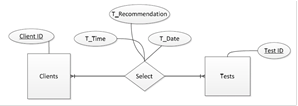 | Figure 1.4. An example of a conceptual model, ERD |
 | Figure 1.5. Mapping of Conceptual into logical design |
4.2.2. Structured Query Language SQL
The database was designed using Microsoft SQL server 2008 while, the information about different tables, fields, data type, storage space, primary key, foreign key were taken from the logical and physical design phase. The authors have first constructed all the tables, then the data diagram was used to build relationship between the tables (connecting primary and foreign key). Once built, the authors’ ensured referential integrity and made sure that the primary key does not contain duplicate its value[7]. Some of the table constructed is shown in the appendix E.SQL stands for structured query language and it is used to communicate with any database and it is mainly used for relational database management system. The data is basically stored in one or more objects called tables. Each table contains the attributes of the entity, the data type and length for every attribute and the indication of primary key[7]. This system includes 28 tables in total to be stored in the database. These tables include both entities as well as relationships. The tables in the Microsoft SQL server 2008 will be linked with the graphical user interface that the system designer will develop using Microsoft Visual studio 2008. A sample of SQL table with a relationship is shown in appendix E.In the next section, the implementation of the automated system for counselling and career services along with running pages of the system is shown. The new system functions are developed according to the requirements of the users.
4.3. Implementation Phase
The implementation phase is the last phase of the SDLC, which is basically the implementation of the solution that was proposed for the problems found in the analysis phase. In the implementation phase, the system was implemented and was functioning according to the demands of the user community. Users could access the system using their own usernames and passwords. Moreover, they could perform the functions that they requested to be automated. All the forms, documents and sheets were added in the system. Lastly, LINQ (stands for Language Integrated Query) was used to connect the databases to the graphical user interface.The students’ problem of not being aware of the CCS was solved by introducing the system to them and distributing them a hard copy of the user manual. Moreover, the first page of the system consisted of information of the CCS function in order to make the students aware. The login page is shown in figure 1.6.The confidentiality issue was resolved by allowing the system to be secure with a username and password. The students were advised to keep their password tricky. Each user in the use-case diagram has a different view of home page according the function they need to perform. Figure 1.7 shows the students’ homepage. In the students’ homepage, they have 6 links options. They can enter, update, and view profile information. Profile information page is shown in figure 1.8.Assessment center includes the personality tests. The students’ assessment center page is shown in figure 1.9. Note that the faculty tests will be different than the students test. The test is available in both English and Arabic language. | Figure 1.6. Login Page |
 | Figure 1.7. Students’ Homepage |
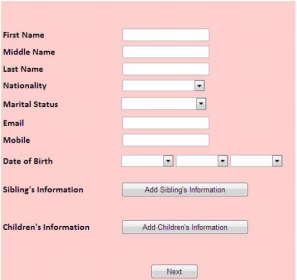 | Figure 1.8. Profile Information Page |
 | Figure 1.9. Students’ Assessment Center Page |
 | Figure 1.10. Counseling session link page |
Counseling services include the option to request for a counseling session by appointment. In the counseling session there are two main functions. (1) The student can ask personal / anonymous questions. (2) The student can request for a counseling session. Figure 1.10 shows the counseling session link page. Brief information about the timings’ is written. The remaining three links in figure 1.7 are extra help for the students. “Career and major” contain articles that inform students about job opportunities or about the skills needed in the job market. “Specialist’s profile” includes background information about the counselors in order to show the students that the CCS staffs credibility. The homepage of the faculty and staff and the job applicants is similar to the students’ homepage only the link options are different. The faculty has a link to refer a student. Lastly, the implementation phase ends by showing the working system to the counseling and career services department staff, faculty members and few students groups and taking their feedback regarding the use. They were all very impressed and showed their interest in using the system.
5. Conclusions
By following SDLC, the authors have developed a system that automated the counseling and career services provided by Dar Al Hekma College, a higher education institute in Saudi Arabia. This solved a lot of problems that were faced by the counseling and career services department, the students and other stakeholders within the college. The prototype of the working system was shown to the users (a group of 10-16 students, few faculty and staff members, and the counseling and career services office staff) who shown a positive feedback and interest in using such a system. By this the authors’ of this study recommend the higher education institutes to automate their career counseling services in order to increase efficiency and productivity and save a lot of time, energy and efforts of the students, faculty, and staff. The limitation of this research was that the entire process of SDLC was carried out by one person who played the role of system analyst, system designer and programmer. Moreover, the timeframe was very limited and was only for four months. In this timeframe, it was not possible for the authors to experiment or have an in depth analysis of the impact of the working system in statistical calculations. The authors of this study would like to recommend other researchers to expand this research by actually implement such a system and study its impact in quantitative terms.
ACKNOWLEDGEMENTS
The authors of this research would like to thank Dar al hekma college, hekma school of business, and the counseling and career services office staff.
Appendix A
Question 1: Please indicate your level of education: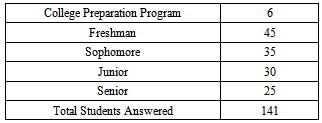 Question 2: Do you have a career and counselling services in your college?
Question 2: Do you have a career and counselling services in your college? Question 3: How often do you visit the career and counselling services office?
Question 3: How often do you visit the career and counselling services office? Question 4: How important for you is the counselling and career services?
Question 4: How important for you is the counselling and career services?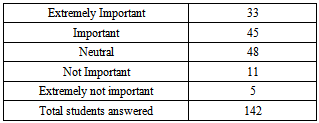 The following question was asked randomly from the students Question 5: What is the reason for not utilizing the counseling and career services?How to read the table? For example, the first row is read as “Total students attended means 142 students were given this option “I didn’t knew about it” when asked the above question and out of 142 only 65 students answered that yes they didn’t knew about the CCS services that’s why they did not utilized the services.”
The following question was asked randomly from the students Question 5: What is the reason for not utilizing the counseling and career services?How to read the table? For example, the first row is read as “Total students attended means 142 students were given this option “I didn’t knew about it” when asked the above question and out of 142 only 65 students answered that yes they didn’t knew about the CCS services that’s why they did not utilized the services.” Question 6: If a new system is installed that will help you to get career counselling through the web, will this help you to use more of the career counselling services?
Question 6: If a new system is installed that will help you to get career counselling through the web, will this help you to use more of the career counselling services?
Appendix B
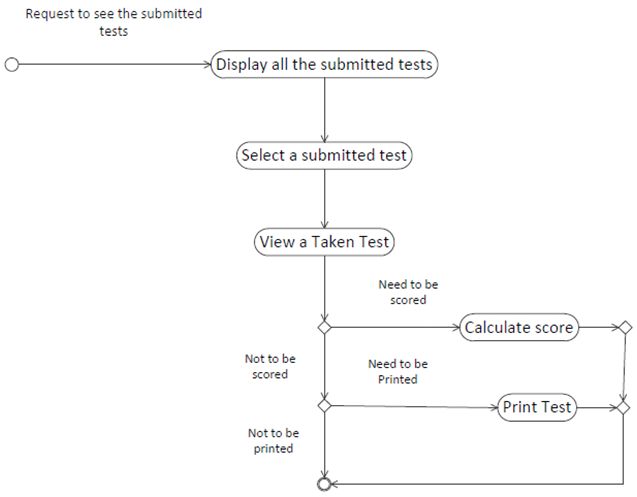 | An activity diagram |
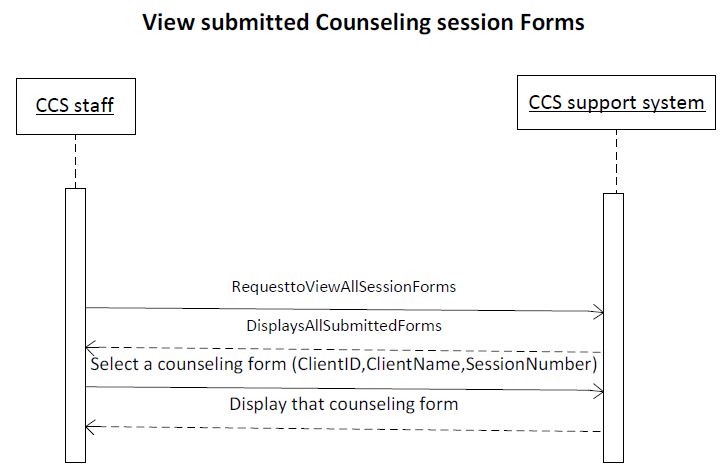 | A sequence diagram |
Appendix C
 | ERD diagram |
Appendix D
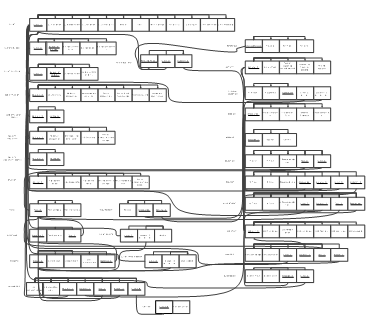 | Logical design |
Appendix E
 | SQL tables in microsoft sql server 2008 |
A database diagram from MS SQL, showing relationship between the client table and sibling table with the primary and foreign key.
References
| [1] | Thomas J. Hayes, “Marketing Colleges and Universities: A Service Approach”, Published by Council for Advancement and Support of Education (CASE), chapter 1, pp. 11, 2009. |
| [2] | A.G.Watts, “The Role of Information and Communication Technologies in an Integrated Career Information and Guidance System”, National Institute for Careers Education and Counseling, Commissioned jointly by the European Commission and the OECD, pp. 4-9, United Kingdom, November 2001. |
| [3] | Obi, Oye, Prof Dr. Tajudin Bin Ninggal and Bernice Amos, “The Impact of ICT on Career Counseling Services: A case Study of Nigerian Secondary Schools”, Department of Information Systems, Universiti Teknologi Malaysia, International Journal of Evaluation and Research in Education (IJERE), Vol.1, No.1, pp. 1~16, Malaysia, July 2012. |
| [4] | Dar Al Hekma College, “About DAH”, Jeddah, Saudi Arabia, available online www.dah.edu.sa |
| [5] | “System Development Life Cycle Methodologies to consider”, Oracle, Online available:http://docs.oracle.com/cd/B19306_01/appdev.102/b14303/deploy.htm#BABIIECC |
| [6] | Kenneth C. Laudon, Jane P. Laudon, “Management information systems: Managing the digital firm”, 11 edition, pp. 515-527, Pearson Education, New Jersey, 2010. |
| [7] | Lonnie D. Bentley, Jeffery L. Whitten, “System Analysis & Design for the Global Enterprise”, 7th ed., McGraw- Hill/Irwin, USA: New York, 2007. |
| [8] | Dictionary, “Discussion”. Available onlinehttp://dictionary.reference.com/browse/discussion. |
| [9] | Survey Monkey. Available online www.surveymonkey.com |











 Question 2: Do you have a career and counselling services in your college?
Question 2: Do you have a career and counselling services in your college? Question 3: How often do you visit the career and counselling services office?
Question 3: How often do you visit the career and counselling services office? Question 4: How important for you is the counselling and career services?
Question 4: How important for you is the counselling and career services? The following question was asked randomly from the students Question 5: What is the reason for not utilizing the counseling and career services?How to read the table? For example, the first row is read as “Total students attended means 142 students were given this option “I didn’t knew about it” when asked the above question and out of 142 only 65 students answered that yes they didn’t knew about the CCS services that’s why they did not utilized the services.”
The following question was asked randomly from the students Question 5: What is the reason for not utilizing the counseling and career services?How to read the table? For example, the first row is read as “Total students attended means 142 students were given this option “I didn’t knew about it” when asked the above question and out of 142 only 65 students answered that yes they didn’t knew about the CCS services that’s why they did not utilized the services.” Question 6: If a new system is installed that will help you to get career counselling through the web, will this help you to use more of the career counselling services?
Question 6: If a new system is installed that will help you to get career counselling through the web, will this help you to use more of the career counselling services?
 Abstract
Abstract Reference
Reference Full-Text PDF
Full-Text PDF Full-text HTML
Full-text HTML



